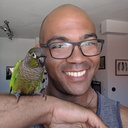
Taylor HainsUniversity of Chicago | UC · Committee on Evolutionary Biology
Taylor Hains
Bachelor of Arts
About
17
Publications
3,566
Reads
How we measure 'reads'
A 'read' is counted each time someone views a publication summary (such as the title, abstract, and list of authors), clicks on a figure, or views or downloads the full-text. Learn more
66
Citations
Introduction
Additional affiliations
January 2020 - September 2020
Education
September 2020 - May 2026
May 2019 - May 2021
September 2010 - May 2015
Publications
Publications (17)
We present the complete genome sequences of 37 Ecuadorian bird species widespread throughout the tropical Andes.
We present complete genome sequences of 23 species of finches from 6 genera.
We present genome assemblies for 18 snake species representing 18 families (Serpentes: these new genome assemblies, we extracted thousands of loci commonly used in systematic and phylogenomic studies on snakes, including target-capture datasets composed of UCEs and AHEs, as well as traditional Sanger loci. Phylogenies inferred from the two target-c...
We present genome assemblies for 18 snake species representing 18 families (Serpentes: Caenophidia): Acrochordus granulatus, Aparallactus werneri, Boaedon fuliginosus, Calamaria suluensis, Cerberus rynchops, Grayia smithii, Imantodes cenchoa, Mimophis mahfalensis, Oxyrhabdium leporinum, Pareas carinatus, Psammodynastes pulverulentus, Pseudoxenodon...
We present partial genome sequences of 50 salamander species (Urodela) from 10 genera and 4 families. These span nearly the entire range of genome sizes in salamanders, from ~14–130GB, the latter of which is among the largest of all animal genomes. Only three salamander genomes were available to this point, from Ambystomatidae (one species) and Sal...
Similar to other insular birds around the world, the Galapagos rail (Laterallus spilonota Gould, 1841) exhibits reduced flight capacity following its colonization of the archipelago ~1.2 mya. Despite their short evolutionary history, rails have colonized seven different islands spanning the entire width of the archipelago. Galapagos rails were once...
Understanding the genetic basis of convergence at broad phylogenetic scales remains a key challenge in biology. Kingfishers (Aves: Alcedinidae) are a cosmopolitan avian radiation with diverse colors, diets, and feeding behaviors—including the archetypal plunge-dive into water. Given the sensory and locomotor challenges associated with air-water tra...
We present the complete genome sequences of 19 species of snipes from 7 genera. Illumina sequencing was performed on genetic material from museum specimens. The reads were assembled using a de novo method followed by a finishing step. The raw and assembled data are publicly available via Genbank.
We report the first chromosome-length genome assemblies for three species in the mammalian order Pholidota: the white-bellied, Chinese, and Sunda pangolins. Surprisingly, we observe extraordinary karyotypic plasticity within this order and, in female white-bellied pangolins, the largest number of chromosomes reported in a Laurasiatherian mammal: 2n...
Hybridization is a known source of morphological, functional and communicative signal novelty in many organisms. Although diverse mechanisms of established novel ornamentation have been identified in natural populations, we lack an understanding of hybridization effects across levels of biological scales and upon phylogenies. Hummingbirds display d...
The Carolina Parakeet ( Conuropsis carolinensis ) is an extinct species of parrot that was native to the eastern, midwest, and plains regions of the United States. We present the whole genome sequence of this species. Illumina sequencing was performed on a genetic sample from a single captive individual. The reads were assembled using a de novo met...
We present the complete genome sequences of 94 species of parrots from 40 genera. Illumina sequencing was performed on genetic material from single individuals. The reads were assembled using a de novo method followed by a finishing step. The raw and assembled data is publicly available via Genbank.
The remarkable radiation of South American (SA) canids produced 10 extant species distributed across diverse habitats, including disparate forms such as the short-legged, hypercarnivorous bush dog and the long-legged, largely frugivorous maned wolf. Despite considerable research spanning nearly two centuries, many aspects of their evolutionary hist...
The Spix’s Macaw ( Cyanopsitta spixii ) is a critically endangered parrot that was once endemic to Brazil. We present the whole genome sequence of this species. Illumina sequencing was performed on a genetic sample from a single captive individual. The reads were assembled using a de novo method followed by a series of references from related speci...
Amazon parrots (Amazona spp.) colonized the islands of the Greater Antilles from the Central American mainland, but there has not been a consensus as to how and when this happened. Today, most of the five remaining island species are listed as endangered, threatened, or vulnerable as a consequence of human activity. We sequenced and annotated full...
The parrots (Psittaciformes, Aves) are a group of colorful, intelligent, long-lived birds with a wide range of body sizes and plumage colors and patterns. One third of the parrot species is threatened with extinction due to habitat loss and the pet trade, a larger percentage than any other comparable bird order. We present the complete genome seque...
Within the Canidae, the African wild dog (Lycaon pictus) is the most specialized with regards to cursorial adaptations (specialized for running), having only four digits on their forefeet. In addition, this species is one of the few canids considered to be an obligate meat-eater, possessing a robust dentition for taking down large prey, and display...















































